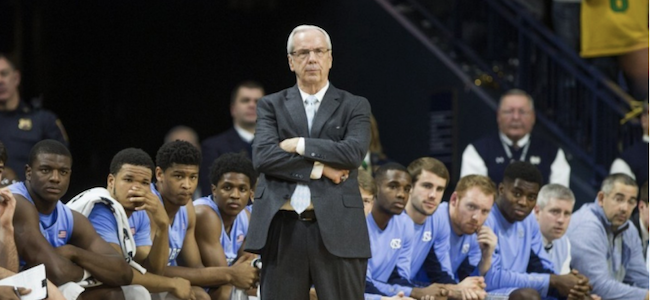When it opened in 1986, the Dean E. Smith Student Activities Center was a new gold standard for college basketball venues.
Fast forward 30 years, however, and UNC officials are caught in a dilemma as they ponder the future of the facility.
Should the school spend millions adding luxury boxes and other modern amenities, or should it attempt to raise funds to construct a new arena? If it goes with the latter, where would the new facility be located?
In 2013, a Kansas City-based architectural firm called 360 Architecture developed two concepts for UNC. One calls for an extensive renovation of the Smith Center, creating three levels of premium seating, expanding the concourse, installing a new video board and reducing the total capacity from over 21,000 to approximately 17,600 seats.
The other concept calls for a new arena built adjacent to the Smith Center on UNC’s South Campus, with luxury boxes and total seating of approximately 16,000.
“If the cost of renovation is so high, at some point it makes sense to build new,” UNC Director of Athletics Bubba Cunningham said in a 2013 article in the Carolina Alumni Review. “We need to explore that.”
The fact that UNC just invested over $4 million in facility improvements would suggest that there’s no immediate push to leave the Smith Center. According to Inside Carolina, the university received approval from the Board of Governors in March to upgrade the locker rooms, shower facilities and players’ lounge. Construction was completed prior to the start of the season.
Regardless of the direction the school goes, each scenario has its drawbacks.
One long-standing criticism with the Smith Center, going back to its early years, has been the perception that it doesn’t offer the Tar Heels the same type of home-court advantage that it would if students were closer to the floor. After UNC’s loss at Indiana last week, head coach Roy Williams praised the Hoosiers for the atmosphere in Assembly Hall, noting that he wished Carolina’s fanbase would get up for every opponent as it does when the Tar Heels play Duke.
The Smith Center was constructed, at a price tag of approximately $34 million, entirely by private funds. More than 2,300 donors participated, with the larger donors receiving lifetime options for seating near the court.
Some, but not all, of those donors can be accommodated through luxury suites in a renovation concept. The plan that UNC commissioned through 360 Architecture calls for the installation of premium seating that would seat approximately 1,400 spectators — less than 10 percent of full capacity.
Logistically, UNC must determine where the remaining donors would be seated, while simultaneously working to get the students closer to the floor — a daunting proposition that will undoubtedly leave hurt feelings no matter what final decisions are made.
In the new arena concept, UNC has to figure out where to build. While the area adjacent to the Smith Center has been suggested, that would leave even less parking on a campus notorious for its lack of parking spaces.
Even though UNC has deep pockets, an off-campus arena may prove to be cost-prohibitive in relation to an upgrade of the Smith Center.
Should UNC find a suitable location somewhere off campus, there are concerns as to how much it would cost to purchase the land, as well as logistical issues related to parking, public transportation and infrastructure, such as roads and sidewalks leading into the new facility.
Each of these issues must be sorted out before the university can move forward with a formal plan to either renovate or replace the Smith Center.

















